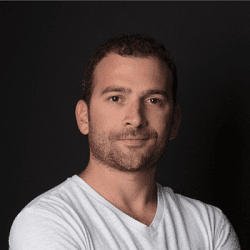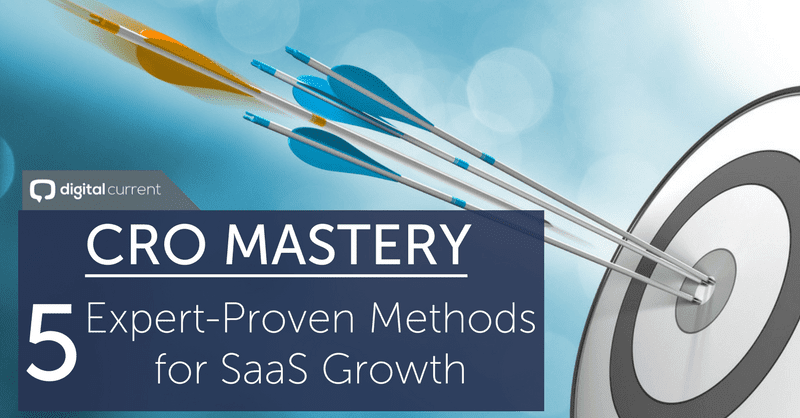Optimize your SaaS website for maximum sales and engagement using these 5 validated conversion optimization strategies from the experts.
Conversion rate optimization is essential for any website. However, the undulating Software-as-a-Service (SaaS) business model demands particularly impeccable attention to detail and ongoing CRO experiments.
Why?
REASON #1): Many SaaS brands focus intensely on recurring revenue that maximizes profitability; and for repeat sales, the entire customer experience needs to be obsessively optimized.
Yet — simply holding, up-selling, and/or cross-selling customers isn’t a substantial (or speedy) growth strategy.
Leading us nicely on to…
REASON #2): Customers must also be acquired at a faster rate than your level of churn, which requires you to stand tall above any competitors in the ever more saturated fight for attention in the SaaS industry.

“If your Net Revenue Churn is high (2%+ per month), it’s a clear indicator that something is wrong in your business.”
(Source: For Entrepreneurs)
The concept of conversion optimization must be baked into everything you do, in order to not only survive customer drop-off — but grow.
So, what exactly does modern CRO entail?
A conversion can mean any desired action from a visitor, user, or customer that is important to a specific goal — whether directly attributed to $$$$$, or not.
Visualize conversion optimization as a two-pronged, experience-focused approach that gathers all types of feedback in order to constantly adapt and improve how people interact with your brand properties; encouraging the precise actions you wish visitors, users, and customers to take.
This strategy involves…
- Optimizing the entire user / customer journey, both externally and within your product
While also…
- Making relatively less conspicuous tweaks, like button color changes and price adjustments

Cutting through the science, sometimes overwhelming lingo and extremely intricate nature of conversion rate optimization — I’ve gathered five inspiring SaaS founders and CEOs who are actively testing numerous conversion optimization strategies (each and every day) in their own successful businesses.
They truly breathe these methods, because growth is their oxygen.
Discover their 100 percent transparent wins and losses (in language we can all understand) — and let their honorable years of collective experience spark the rocket fuel for your SaaS brand’s conversion voyage!
Prepare to optimize…
Method #1: Gain Complete Funnel Transparency (& Evaluate Tools)
 Daniel Kempe is a dynamic, sought-after startup advisor. He is also the respected co-founder of Quuu and Quuu Promote — hugely popular, thriving social media platforms that provide 1) hand-curated content suggestions, and 2) get your content shared by influencers — on auto-pilot!
Daniel Kempe is a dynamic, sought-after startup advisor. He is also the respected co-founder of Quuu and Quuu Promote — hugely popular, thriving social media platforms that provide 1) hand-curated content suggestions, and 2) get your content shared by influencers — on auto-pilot!
“One of the biggest challenges for us is that Quuu Promote is a new concept in content promotion; which means educating our users is integral to converting them into regular paying users.
After using Hotjar (a tool to track funnels) and Intercom (for automated messaging), we found it really hard to segment users based on where they were in the funnel — necessary to determine which messages worked best.
These tools weren’t working for us, so we built our own tool to facilitate our exact needs. We called it Sython.
One of the biggest tests we wanted to run was whether asking for a credit before or after a trial was better, so we used Sython to track the numbers.
Here are results when credit card details were requested on initial sign up:

After running this for a little while, we saw the biggest drop-off occurring on our credit card form — where we were losing 58 percent of visitors.
Here are the numbers when credit card details were requested after the trial:

The bottom line?
Asking for payment after the 14 day trial gave us an overall conversion rate of 7.34 percent, an improvement of 4.73 percent. That’s more than double the conversions, with less traffic (after this one simple change).
Continually keeping track of your onboarding flow allows you to make calculated decisions.
Using Sython allowed us to send the right messages at the right time.
Not everybody has the resources to create their own tools in-house, but the good news is we are planning on launching Sython as a standalone product in the near future.
If you notice big drop-offs at stages of your funnel, you can take action to continually improve the overall conversion rate. The only real way to do this is by testing, all the time.”
Method #2: Adopt the CRO Mindset (& Place Users at the Center)
 Yam Regev is a data-driven (plus highly emotionally-intelligent) SaaS mastermind and co-founder of Zest — the innovative Chrome extension that helps you promote and find amazing content in just a few clicks. Every piece of material is rigorously checked (by Zest’s own users!) and only the best is approved. Strictly no click-bait included.
Yam Regev is a data-driven (plus highly emotionally-intelligent) SaaS mastermind and co-founder of Zest — the innovative Chrome extension that helps you promote and find amazing content in just a few clicks. Every piece of material is rigorously checked (by Zest’s own users!) and only the best is approved. Strictly no click-bait included.
“For us, CRO isn’t a ‘hit and run’ kind of action. Like, ‘Let’s change the CTA color or write $1,000 instead of $1000 in our pricing plans — and we’re done!’
CRO is a way of (business) life at Zest; a holistic perception of how we approach our users, what and how we communicate to them, and how we ‘do’ growth, here.
We call it ‘User Success.’ Basically, we took ABM methodologies and merged them with Customer Success disciplines. It generates huge WoM (Word of Mouth) and a solid funnel.
Instead of making our clients successful, we are making our users successful. So, all the actions that your Customer Success reps may be undertaking, we do the same — but in our case, we are doing it when users are still exploring our platform — not only when they convert into paying clients.
How do we do that?
First, we take away all automation tools. These tools can be classed as growth-preventers for early stage startups. We want our users to ‘feel the warmth of our hand on their shoulders,’ so we defined three things:
- All communications are manual, even if it is taking us longer to respond. This method alone helped us to achieve product-market fit in 1.5 months, as we had hundreds of 1:1 communications with our targeted audience and users.
- Authenticity above all. I’m not talking about transparency. At Zest, we are creating a movement. We already created the basics of it, as we have 13k WAU (Weekly Active Users) and dozens of volunteers who are part of our content distillation process. Our authenticity isn’t only shown in our communication — it is also presented on our website, emails, Facebook posts, Medium articles, etc…

3. Added value in all communications. This is a deal breaker for many of our marketing initiatives. We always ask ourselves, “Is there added value in this follow-up email we are going to send to a potential client?” If the answer is NO, we will come up with hyper-creative ideas that will inject added value to every communication we have with possible customers.
All of the above creates ultra-growth for Zest. We are sticking to these principles at every stage of the funnel — and the user feedback / numbers are testament to this dedication.
Although none of our methods are groundbreaking, simplicity is a lifesaver for us.
And each method applies CRO as a starting point.
Let’s show you some examples…
TOP FUNNEL CRO: Authenticity + Community Involvement
The below articles show how we share our internal thought process and involve our members in decisions we take:


We also encourage our members to write about their Zest experience.
Traffic generated through WoM will convert best at any stage of your funnel…

Let your users speak for you. On our site, we don’t have many sections where we write about what our platform does or how it functions. For each page, one of our members describe us, instead…

As time goes by, we optimize our on-site and off-site messages. The more accurate we become, the better our top-of-funnel conversion rates.


Combining these top-of-funnel, CRO-based actions — we were able to grow 5.5 times in Weekly Active Users, while also dramatically improving our on-site conversion ratio by a whopping 25 percent.
MID FUNNEL CRO: The Who, What, Why + Exclusive Waitlist
We created a unique landing page. Not your ordinary pricing page, but a visual representation of who’s using our product, what our premium offer does for your traffic, and a notable strategy — you can only join the waitlist, not buy.
We took this approach as we wanted to communicate with our potential clients, face-to-face.
This method proved itself in a matter of weeks; we were able to find our pricing / market fit.
The following examples are just a couple of CRO techniques we use on this page…
Tell your potential users or clients exactly what contact to expect, and from who!

Visualize your USP, like this:

At Zest, CRO became a mindset.
Once your put your users in the center (really in the center, not just as a cliché), CRO will develop into a harmonious, cross-channel effort consisting of three important ingredients: Authenticity, added value, and 1:1 communication.”
Method #3: Launch Optimized Giveaways (& Geographically Personalize)
 Sarosha Imtiaz is an esteemed, people-focused AI enthusiast and innovative co-founder of the award-winning AIVA Labs — an intelligent conversion optimization tool that swiftly transforms websites into smart engagement hubs, ready to attract maximum sales!
Sarosha Imtiaz is an esteemed, people-focused AI enthusiast and innovative co-founder of the award-winning AIVA Labs — an intelligent conversion optimization tool that swiftly transforms websites into smart engagement hubs, ready to attract maximum sales!
“Businesses often ask us what kinds of campaigns generate the highest conversion rate for a website. We usually have one succinct answer: Giveaways.
At Aiva Labs, we practice what we preach. Typically for SaaS companies, it’s tough to come up with a giveaway idea that doesn’t revolve around discounting the core product. We wanted to offer something unique to our users that would also provide value to their business.
Our customers often turn to us for design and conversion assistance, so we decided to present a free consultation to anyone who visited our website — to help them boost their engagement.
For optimal results, our team created personalized campaigns which would resonate with audiences across different geographical regions.
With Aiva’s analytics, we determined the majority of our website traffic was from Canada, USA, and the U.K. So, we used the Aiva builder to create a beautiful starting point for our design, which was branded to our website (including a winter theme).
Using the multivariate testing functionality, we quickly created different variations and targeted our key demographics.
By tweaking imagery to reflect geographically relatable landmarks, we were able to cater personalized calls-to-action and impress our global visitors.
Check out our designs in the GIF below:

We ran these overlays for about a month, collected outstanding results — and learned how visitors behave on our website!
We were happy to see over 40 percent of users entered their email to qualify for the giveaway.
We have also successfully converted many of these new signups into paying customers.
Rather than further testing the design of these campaigns, we decided to test which triggers would convert best. We initially showed the overlays to all website visitors, but using Aiva’s Recent Activity Tracker, we quickly realized the pricing page resulted in the most conversions.
By consistently testing how the overlays were being targeted on our website — we found that displaying the giveaway solely on the pricing page, to users who visited the page more than twice, who didn’t take action for six seconds — actually acquired the majority of signups.”
Here are the results:

Method #4: Simplify Signup Forms (& Do Sweat the Details)
 Michal Sadowski is a vibrant entrepreneur, avid traveler, video producer, mentor, SaaS devotee, and the CEO / founder of Brand24; a product renowned for providing intelligent alerts of brand mentions across the entire web! Brand24 is trusted by the likes of IKEA, Intel, H&M plus 100,000 other companies.
Michal Sadowski is a vibrant entrepreneur, avid traveler, video producer, mentor, SaaS devotee, and the CEO / founder of Brand24; a product renowned for providing intelligent alerts of brand mentions across the entire web! Brand24 is trusted by the likes of IKEA, Intel, H&M plus 100,000 other companies.
“Implementing funnel tracking via tools like Heap, Hotjar, and FullStory allowed us to boost our volume of new customers — three times over!
How?
We vastly simplified our signup form, omitting all but only two input fields: Email and password.
Social proof and a couple of humble brags were also displayed.
Our conversion rate on this form grew 300 percent — we literally started to acquire three times more customers, just by simplifying our signup process!
After granular analysis, we (interestingly) found that an optional “promo code” input field was the main culprit, generating high bounce rates.
People were trying to find promo codes online (with little luck), so they abandoned our signup route altogether.
Therefore, we moved the “promo code” input field to a separate signup form — now shown only to affiliates.”
Here is the old form:

And the new form:

Method #5: Test Free Trial Positioning (& Focus on Value)
 Ayush Mittal is a dedicated, highly driven entrepreneur (and super-approachable guy!) who successfully heads two SaaS companies: PostmastR and RefR. The latter is a content-focused platform that offers ultra-personalized social media content delivered to your feed, complete with custom graphics (created manually)!
Ayush Mittal is a dedicated, highly driven entrepreneur (and super-approachable guy!) who successfully heads two SaaS companies: PostmastR and RefR. The latter is a content-focused platform that offers ultra-personalized social media content delivered to your feed, complete with custom graphics (created manually)!
“Many SaaS solutions activate their funnel with a 14-day or 1-month free trial (where payment is requested after the trial).
It is a typical means to onboard new users. As it turned out for PostmastR (involving a great deal of personalization and human effort), a considerable amount of users became inactive by the end of the trial, and far too many signed up to merely exploit and leave once the trial concluded.
The question arose: Should we charge a small fee for the trial, or test a few scenarios to find a sweet spot for converting more free trials?
After a lot of thought, planning, and white-boarding — we decided to go for the latter option.
Our 14-day free trial was axed in half, and we first noticed a small boost (~1 percent) in our trial-to-paid conversions.
Considering a hyper-personalized SaaS offering like ours, we had to find an even better way to up our conversion game…
Our second tactic was to remove the time-based trial, and instead, offer a defined value-based demo of the product to filter out the low-quality leads coming in at the top of the funnel.
These are the stages of development, in order:

⇩

⇩

As it turns out, we experienced a ~6 percent lift in trial-to-paid conversions.
While it’s still early days with a small set of data, the results are already promising.

Our Key Takeaway:
If your SaaS is a hyper-personalized offering and you are struggling with low conversion rates, consider reviewing your trial options.
Independent of trial length, defining the value of what the trial users receive will likely give them enough proof.
For us: Most of the users on trial who ended up converting to paid customers, made this decision before the trial period ended. They were enabled by instant gratification.
Qualify users early-on in their buying journey without extending the onboarding process.
If your users can unleash the potential of your product and easily understand how their problems are solved with your unique solution, there is simply no need for a time-based free trial.
In the end, it’s happy experiences that count!”
Wrap-Up
You’re now well-equipped with an array of validated CRO techniques that any SaaS brand can begin implementing for rocket-propelled growth, today.
[Don’t forget to also check out these expert-proven SaaS SEO strategies!]
Our featured industry specialists have unveiled a collection of sharp, lesser-known conversion methods that have very recently driven awe-inspiring results for their businesses.
Huge appreciation and credit to them!
Use their hard-earned experience to better your brand’s revenue while reducing that wicked SaaS killer: Churn.
REMEMBER: Never, ever stop testing. There is always room for improvement in conversion rates — and experimentation is the very pulse of conversion optimization.

